Native bees often better pollinators than honey bee
Honey bees get most of the buzz, but some native bees are better at spreading pollen. They may hold the solution to world pollination problems that affect important crops.
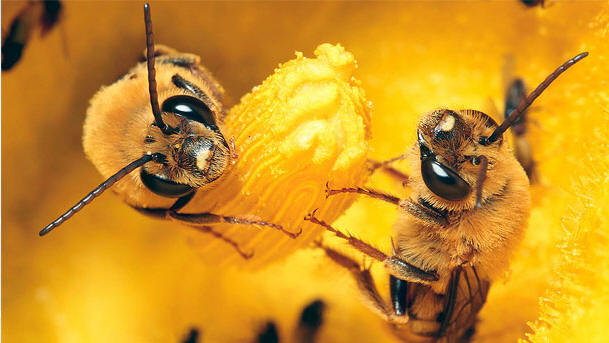
In 2007, the world was introduced to a plague so disturbing it seemed almost biblical. Out of the blue, honey bees were dropping dead or worse, vanishing into the air by the millions. In the four years since, colony collapse disorder (CCD) has been a regular resident on newspaper front pages as scientists desperately try to puzzle out what’s wrong.
Certainly the stakes are high, considering that 35 percent of the world’s crops — amounting to $216 billion per year — depend on various creatures to ferry pollen from one flower to another. And certainly, if scientists cannot help honey bees recover, it could dramatically affect the price of food.
What is not so certain is whether the familiar honey bee is really the only game in town.
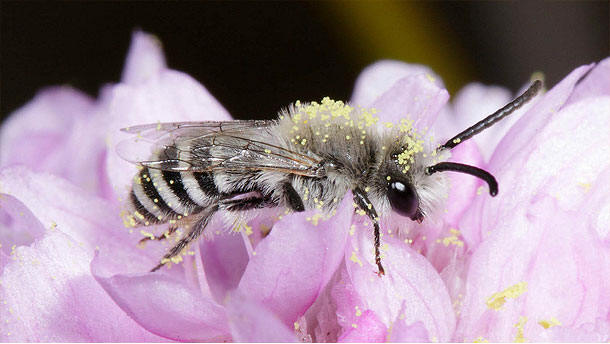
“The alfalfa leafcutting bee has been in commercial use since the late '50s, early '60s,” says UC Davis professor emeritus Robbin Thorp. “Since the early '90s, bumble bees have been commercially produced for tomato greenhouse production and in a number of outdoor crops where honey bees are not the most effective pollinator. Like blueberries and cranberries.”
Thorp is the patriarch of a rag-tag group of scientists who have pioneered research on non-honey bees that just may hold a solution to the world’s pollination problems. For those who don’t own boxes of pinned and labeled bugs, it may come as a surprise that most of the world’s bees don’t live in hives or make honey. In fact, California alone has some 1,600 species of native bees, with names like the blue orchard bee, the squash bee and the teddy bear bee (this is not counting wasps and yellow jackets, which many bee researchers sarcastically call “ants with wings”).
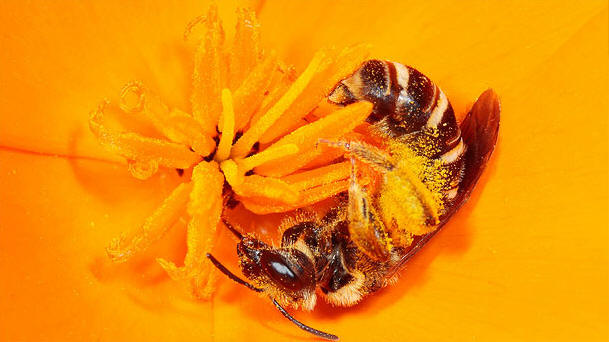
They may be green or brown, shiny as a chrome fender or furry as an ape, big as a bumble bee or barely visible to the human eye. But almost all of them can pollinate flowers — some of them quite well. This was the conclusion of a seminal 2002 paper by three UC scientists, including Thorp, in “The Proceedings of the National Academy of Sciences.”
Messy but effective
In some cases, native bees — which often don’t have tidy pollen pouches on their legs — are messier than honey bees, and thus better at spreading pollen around. In other cases, natives just shake more loose. In fact, tomato farmers may see 50 percent more tomatoes that are twice as big if they get regular bumble bee visits.
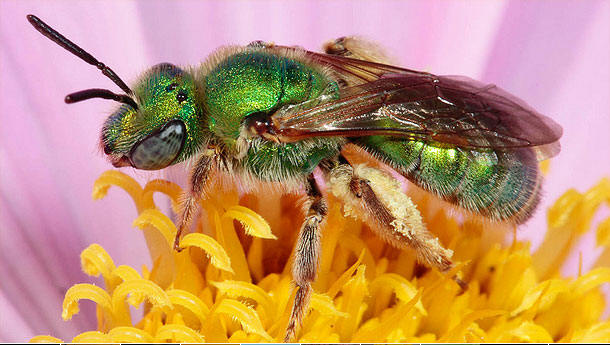
“We’ve known for a long time that native bees can be effective pollinators. The problem in my mind is: Can we take that information and implement it?” says Gordon Frankie, who has studied native bees at UC Berkeley for several decades.
So why the global obsession with the one species that makes honey? For one, honey bees have hives, which makes them easy to keep and transfer en masse. For another, some native bees are picky about which flowers they prefer and where they live. As a result, commercial pollination is almost wholly dependant on honey bees.
“We are very much reliant on honey bees, for almonds for example. They require a huge number of pollinators,” says Claire Kremen, UC Berkeley conservation biologist and lead author of the 2002 PNAS paper.
Almonds may be the most bee-dependent crop in America. Without pollinators, the trees simply cannot create fruit. Every February, almond farmers pay $300 per acre for beekeepers to pollinate their land — a price that has tripled since the 1990s.
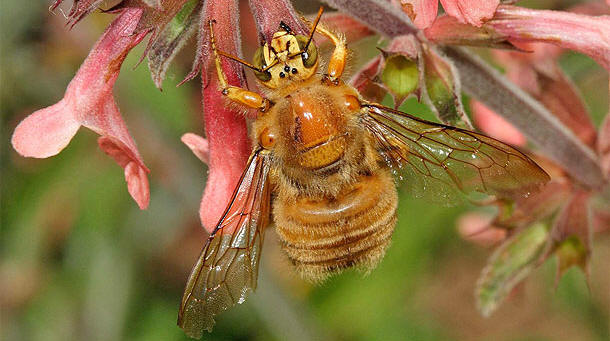
So in 2003 Kremen teamed up with the Xerxes Society, a non-profit group that many call “Audubon for invertebrates.” Together, Xerxes and UC scientists have been making the case across the country that while native bees can never replace honey bees, they may provide a crucial insurance policy.
To employ native bees, farmers must lure the insects onto a farm field with hedgerows of specific flowers they know the bees like. It’s a similar strategy to the one employed by organic farmers who invite predatory insects like ladybugs to rid their crops of pests.
“We’re all worried about colony collapse disorder,” says “Farmer Al” Courchesne of Frog Hollow Farms. “If native bees could step up and provide a service to ameliorate that difficulty, that would be a very big deal.”
Frog Hollow, a small organic farm in Brentwood, Calif., is partnering with Frankie in a 10-year experiment to attract native bees. Meanwhile, Kremen and Neal Williams at UC Davis are working with 30 farms ranging in size from 2 to 80 acres. The goal of all this work is not to replace honey bees, but to pinpoint which native bees are effective, what they can offer and how to lure them into visiting and pollinating.
“Putting hedgerows around a very large 300-acre monoculture is like putting a Band-aid on a wound that needs a tourniquet,” Kremen says. “But it doesn’t have to be an either/or kind of thing.”
Creating buffet for bees
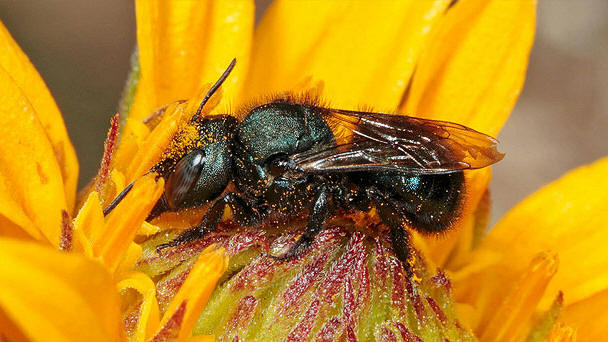
Scientists are realizing that a combination of pesticides, pathogens and poor nutrition probably are the major causes of CCD. Prominent theories suggest the stress of moving from one pesticide-rich monoculture to another makes farmed bees vulnerable to sudden virus outbreaks. On the other hand, a diverse farm sprinkled with various crops and flowers gives all bees — native and honey-making alike — a healthy diet.
Of course, this kind of bee buffet works better on organic farms than massive industrial operations. Nevertheless, the idea to use native pollinators has spread over the last few years from California to farms across the country, all the way to Washington, D.C. Nationwide 60,000 acres of pollinator-specific habitat will be put aside over the next year or two. In 2009, the U.S. Department of Agriculture’s Natural Resources Conservation Service set aside $330,000 from the farm bill for pollination projects in California as well as some of the largest blueberry and cherry operations in Florida, New Hampshire and Oregon.
“Farmers really are stewards of the land. They believe in trying to do things the right way,” says Jessa Guisse, who works with Xerxes to educate and partner with California farmers. She relies heavily on science coming out of UC Davis and Berkeley to help inform farmers.
“The work out at the UC is some of the best work in the country right now,” says Mace Vaughan, who oversees national pollinator work for Xerxes. “They are actually demonstrating the benefits.”
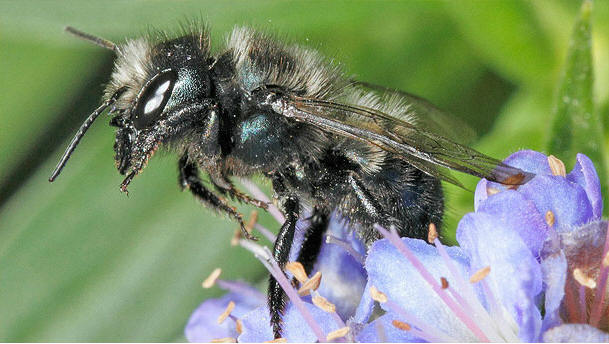
But coming up with specific bee instructions for farmers is hardly straightforward. Differing bee tastes are just the start; they also need someplace to live. Most native bees nest in the ground, while others occupy tubular tunnels, and a few even drill holes in wood. Plus, they may not emerge to start pollinating at the same time of year as honey bees. Farmers wanting to attract native bees have to be careful about plowing their fields and knowing when native bees are likely to become active.
UC Davis’ Williams is working on a way to perhaps pinpoint bee hotspots throughout the state to concentrate efforts. Even so, it may be decades before scientists have a clear understanding of how the diverse tapestry of native bees affects a farm field.
It may be worth it, though. Kremen is still determining the dollar value of native bees, but she says even with minimal effort, farmers may already be getting 25 to 30 percent of their pollination for free from bees they have never heard of. That likely translates to billions of dollars even before the first honey bee touches down. And increasingly farmers are starting to see a potential savior in their own back yard.
“Nothing beats taking a farmer out to squeeze squash flowers (in their fields) and finding squash bees,” says Vaughan, who often leads farm bug-finding tours. “And the farmer suddenly says, ‘I get it.’”
